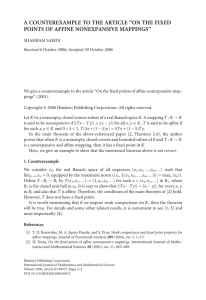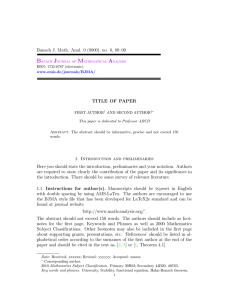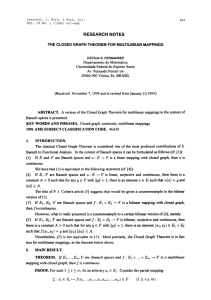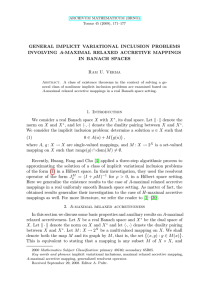ACCRETIVE MAPPINGS EXPANSIONS AND LOCAL
advertisement
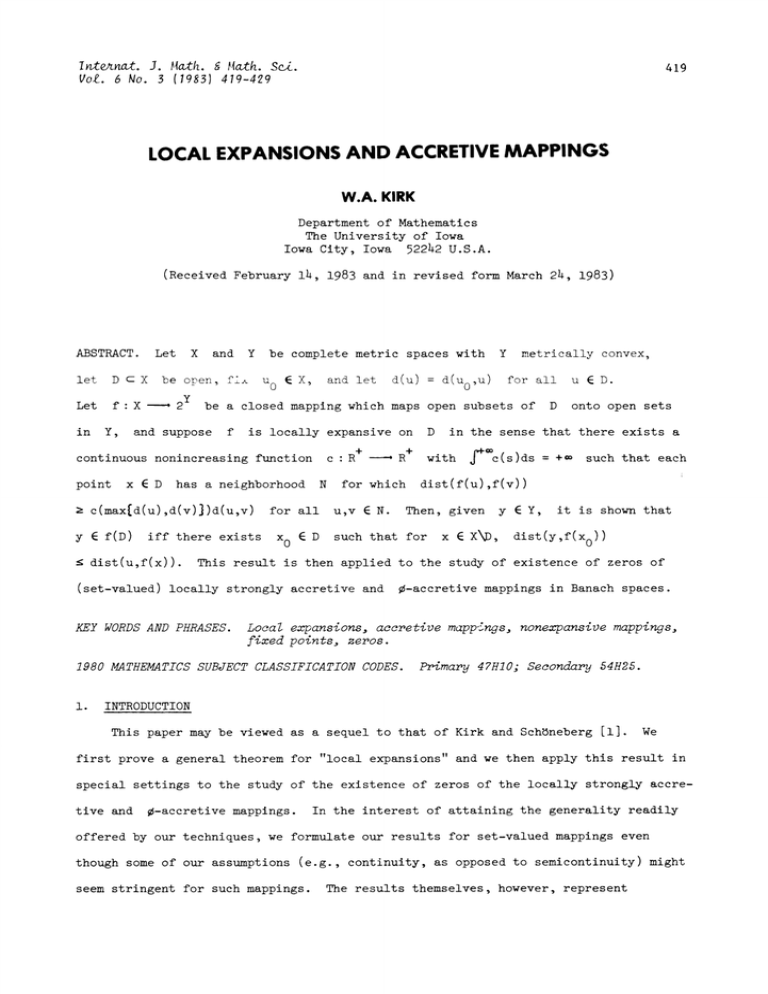
I nternat. J. ath. & ath. Sci.
Vol. 6 No. 3 (1983)419-429
419
LOCAL EXPANSIONS AND ACCRETIVE MAPPINGS
W.A. KIRK
Department of Mathematics
The University of Iowa
lowa City, lowa 52242 U.S.A.
(Received February 14, 1983 and in revised form March 24, 1983)
ABSTRACT.
D c X
let
Let
in
X
Let
Y
X,
0
a
y
E D
f
iff there exists
(set-valued)
c"
N
has a neighborhood
dist(u,f(x)).
for all
for all
x
D
0
R
+
R
for which
u,v
N.
+
D
u
E D.
onto open sets
in the sense that there exists a
c(s)ds
with
+=
such that each
dist(f(u),f(v))
Then, given
such that for
x
E XD,
y 6 Y,
it is shown that
dist(y,f(Xo))
This result is then applied to the study of existence of zeros of
locally strongly accretive and
KEY WORDS AND PHRASES.
-accretive mappings in Banach spaces.
Local expansions, accretive mappings, nonexpansive mappings,
fixed points, zeros.
1980 MATHEMATICS SUBJECT CLASSIFICATION CODES.
i.
D
is locally expansive on
c(max[d(u),d(v)])d(u,v)
f(D)
d(Uo,U)
metrically convex,
be a closed mapping which maps open subsets of
and suppose
x
d(u)
and let
continuous nonincreasing function
point
Y
be complete metric spaces with
u
be open, fi
f" X- 2
Y,
Y
and
Primary 47H10; Secondary 54H25.
INTRODUCTION
This paper may be viewed as a sequel to that of Kirk and SchDneberg
first prove a general theorem for
[i].
We
"local expansions" and we then apply this result in
special settings to the study of the existence of zeros of the locally strongly accretive and
In the interest of attaining the generality readily
-accretive mappings.
offered by our techniques, we formulate our results for set-valued mappings even
though some of our assumptions
(e.g.,
seem stringent for such mappings.
continuity, as opposed to semicontinuity) might
The results themselves, however, represent
420
W.A. KIRK
[i] even in
extensions of those of
the point-valued case.
[2]
Results similar to those obtained here may be found in Ray and Walker
Torrej6n [3]
and in
Torrej6n relies on differ-
however, the methods employed are different.
ential inequalities, while Ray and Walker use the Brezis-Browder order principle to
prove a refined version of the Caristi-Ekeland minimization principle, and this in
turn is used to obtain, among other things, a Banach space version of the surjectivlty
On the other hand, Torrej6n obtains our Theorem 2.1 under
part of our Theorem 2.1.
X
the assumptions that
is a Banach space and
Y
is a complete and metrically con-
While it is likely that the methods of Ray-Walker and of Torrej6n
vex metric space.
could be modified to attain the generality we obtain, our approach, which is a refine-
ment of the argument of Kirk-SchSneberg
of the original work of Browder
[4,
Theorem
4.9])
[1],
seems more direct and more in the spirit
In particular, Browder uses an argument (cf.
[h, h].
roughly like the one we use below to show that a local expansion
from a complete metric space
X
ness hypotheses, actually a covering map of
X
onto
For the most part, we use standard notation.
centered at a point
CY)
and
x
Y
to a metric space
is, under suitable connected-
Y.
B(x;r)
of a metric space with radius
denotes the closed ball
>
r
(denoted by H).
families the usual Hausdorff metric
J X
X*
2
Y,
A
Also, for a subset
Finally, if
[j
X
X,
of
Y
and
is said to be closed if for
2.
y
imply
X,
the map-
x*. ll ll:llxll, <x, >:IIxll
we use
AI
to denote
inf[llxll:
A].
x
are metric spaces, then a set-valued mapping
Ixn ]
in
X,
x
the conditions
n
x,
Yn
x
f" X
2
T(x ),
and
n
A THEOREM ON LOCAL EXPANSIONS.
(X,d)
Let
be a complete metric space and
pathwise connected metric space with intrinsic metric
0
For a Banach space
T(x).
y
THEOREM 2.1.
u
and we assign to these
denotes the usual normalized duality mapping"
(xl
yn
S(Y)
We shall use
to denote, respectively, the family of nonempty bounded closed subsets and
the family of nonempty compact subsets of a metric space
ping
0.
X,
and let
d(u0,u),
d(u)
maps open subsets of
X
u
D.
onto open sets in
Let
Y,
f X
%,
2
let
x
(Y,d)
D cX
a rectifiably
be open, fix
be a closed mapping which
and suppose there exists a continuous
LOCAL EXPANSIONS AND ACCRETIVE MAPPINGS
D
x
(0, )
[0,)
c
nonincreasing function
N
has a neighborhood
c(s)ds
with
421
+
such that each point
for which
dist(f(u),f(v)) a c(max[d(u),d(v)])d(u,v)
for all
N.
u,v
x
There exists
D
0
inf[%(w,y)
In particular, if
PROOF.
assumption
the following are equivalent.
f(h).
(a) y
(b)
Y,
y
Then, given
X,
D
f(D)
y
g
inf[%(w,y)
r(x) >
(0,1): B(x;r)
0
for each
For each
and show that the
D,
x
let
dist(f(u),f(v))
and
h
D,
x
inf[c(d(u))
c
(b) holds
is trivial, we suppose
c(max[d(u),d(v)]d(u,v)
By assumption,
f(x)].
:w
is surjective.
leads to a contradiction.
sup[r
r(x)
f
then
(a) --> (b)
Since
f(x0)}
"w
XD,
x
such that for each
B(x;r)}.
u,v
for all
and moreover if
B(x0;r(x0)/2)},
"u
then
>
0.
Let
u
cr(x0)/h
[Un]c D
We define a sequence
f(uI)
w
I
[0,i]
"
F
%(F),
as follows.
Y
and a path
that the length,
of
joining
x0,
I
w
I
and
y
t
and select
0,
I
(with (0)
w
I)
such
satisfies
f(x0)]+.
f(B(Ul;r(ul)/2))], let [Sn ] [0,i]
where v
B(Ul;r(ul)/2) n= 1 2
n
%(F) m inf[%(w,y) :w
Let
s
n
t
t
sup[t
2
[0,I] F(t)
and let
2
F(s n --r(t 2)
f(vn
F(s n
".’.
l’(t 2)
fact that
Similarly,
Ivn ]
dist(f(vn
converges to some point
f(Vm))
v
M.
cd(vn,Vm)
Also, since
tn+1
and as above obtain
Un+1
y
sup[t
f
Since
f(B(Ul;r(ul)/2)).
f is open implies v
3B(Ul;r(Ul)/2). Now set
having defined [ui], {ti], and [wi] for i
f(v).
Since
and
d(F(s n ),F(Sm))
it follows that
be such that
f(D), y
[0,1] :r(t)
8B(Un;r(Un)/2)
is a closed mapping,
In view of this, the
u
2
v
and
[1,-..,n],
w
2
F(t2).
let
f(B(un;r(Un)/2))]
for which
Wn+ 1 l’(tn+l)
f(Un+l).
422
W.A. KIRK
[Un] [tn]
Thus, by induction, sequences
(i)
tn+I > t n
(ii)
d(Un+i,un)
d(w
n
n=l
,
r(u )12;
[d(Un) ]
,Wn+ I)
so that
d(uj) < d(Un+I)
g
%(r) <
+@.
c(s)
is unbounded, define
i
"k k=l
if
n=l
i
I
and
for
s
>
is the smallest integer
ik+ I
<
d(Uik+l) d(Uik);
c (max[ d (u ),
n
c(s-l)
otherwise, take
j
and select
i
such that
ik+ 1 ik+l.
Then
d(Un+I ] )d(Un Un+"
Z
k=l
cCa(u. ))(a(
k
Uik+l )-(u.k ))
+(R)
S
a
contradicts (iii)and (iv).
Un
Un+l
n=l
This
n
is increasing,
Z
(iv)
[u ]
exist satisfying for
g
[tn]
If
[Wn]
c(max[d(Un)’dCUn+l)])d(Un’Un+l) distCf(un )’ f(un++/-)) < d(Wn,Wn+l).
(iii)
Since
and
Thus
sup[d(ui),
s
i:i,2,-.-] <
+-
and
(iii)
implies
c(s)d(Un,Un+l) d(Wn,Wn+l),
In conjunction with
Since
X
(iv),:
is complete,
follows that
x
the assumption that
f
the above in turn implies that
u
n
is not in
n: 1,2,’’’.
D
x
D.
Moreover, since
t
Also, since
is closed implies
w*
n
t
r(u
[Un]
f(x).
2d(u
n
[0,i],
is a Cauchy sequence.
n
w
n
Un+l
w*
cr(XO)/2 m c(max[d(Ul),d(u2)])d(Ul,U2)
dist(f(ul),f(u2))
d(w ,w2)I
Therefore,
"w
f(x)]
g
%(w*,y)
g
inf[(w,y) w
it
and
To complete the proof, observe
that
inf[(w,y)
F(t),
0
f(w0)]+-d(Wl,W2)
LOCAL EXPANSIONS AND ACCRETIVE MAPPINGS
XD,
x
and, since
m inf[(w,y)
"w
< inf[(w,y)
"w
423
f(x0)}-cr(x0)/h
E f(w0)},
E
(b).
this contradicts
The final assertion of the theorem follows from the fact that, if
(b)
is satisfied vacuously.
3.
APPLICATIONS TO ACCRETIVE MAPPINGS
Let
X
is said to be accretive if for each
(u-v,x-y>+
X*
Since the unit ball of
thus, by Lemma i.i of Kato
is
x,y
A:D
X
2
expansive mapping of
% > 0,
A
then
weak*
for some
c
2X
>
then
A: X- 2 X
A(y):
v
J(x,y)}
j
0.
%
iff for each
0
2
0,
l(x-Y)+l(A(u)-A(v))l.
i > 0,
is accretive if for each
(I+kA)(D)
A(x),
u
X,
compact, the above supremum is attained and
(u-v,x-y)+
[5],
D.
onto
is said to be
A: D
Finally,
D,
We recall that a mapping
sup[(u-v,j>
m
llx-yll
Therefore
D c X.
be a real Banach space and
D
m
J
(I+A)(D)
If
X
(I+A) -1
is a non-
for some
(hence all)
m-accretive.
is said to be strongly accretive if
A-cl
is accretive
0.
For our first application we require the following version of Deimling’s domain
invariance theorem of
([8])
proof
[6].
SchSneberg’s modification (see [7]) of the Crandall-Pazy
of this result carries over from point-valued mappings to set-valued map-
pings without essential change.
THEOREM 3.1 (of.
closed subsets of
X,
[7]).
and
T: U-(X)
open, and let
Let
H
X
(X)
be a Banach space,
(X).
the Hausdorff metric on
be continuous
the nonempty bounded
(relative to H)
Suppose
U c X
is
and satisfy for some
c>O,
(i)
IT(x)-T(Y)I
(ii)
the mapping
R(x)
T(U)
R
U ---(X)
c-l(T(x)-Y0 )-x
llu-vll
Then
clIx-YlI;
2
(x
defined for fixed
U)
X by
U, t
2
satisfies
l(u-v)+t(R(u)-R(v))l (u,v E
is an open subset of
Y0 E
0).
X.
This theorem can be proved as follows.
Let
x
I
U
and
Yl
T(Xl)"
Choose
424
r
W.A. KIRK
>
R
0
p > 0
and
(X)
U
Let
(ii).
as in
x+R(x);
0
thus,
c U.
B(Yl;Cr)
y
Fix
and define
It must be shown that there exists
T(x)-y
0
[0,1]
@
B(Xl;r+p)
so that
[0,i)
y E
and
T(x),
l@(s)ds
satisfy
B(Yl;Cr
from which
<
For
D.
U
x
U,
u
such that
T(U).
c
R(u)
v
and
.
>0,
let
[c
A(u,v,.)
l(u,v,.)
and let
Z(u,v,Z)
a
2
A(u,v,.).
sup
U and
H(R((l-c)u-cv),R(u)) < $(.+i)],
(Since U
is open and
R
yl-Y)-Xl
and select
c
continuous,
.)
Now let
2c
[0,i]" (l-c)u-cv
c
l(Xl,Vl,l).
v
and
i
I
Next,
select
v
and
[vn]
[Xn] [Cn]
and define
c
I
R((l-c2)xl-C2Vl
2
A(x
2
i)
I
so that
recursively by taking
(1-Cn+ 1)xn-cn+lvn,
Xn+ 1
select
v
so that
n
where
I
n
Cn+I A(Xn,Vn,j=l
’ c.)3 is
Vn+1 R(Xn+l) so that
2On+I
chosen so that
2
l(Xn,Vn,jlCj )’
and then
n
n
n
+/-
j=l 3
From this point on it is possible, except for obvious modifications (generally,
replacing
R(x i)
for which
Ix+R(x)l
with
to follow SchSneberg’s proof and obtain a point
v.1
0.
R(x)
Since
0 6
is closed,
x+R(x).
U
x
We refer to [7] for
the details.
We now prove the analog of Theorem 3 of [i].
THEOREM 3.2.
c"
[0, )
[0, )
X
be a Banach space with
in the following
N,
x,y
D
sense"
if
is continuous on
T(x)
u
z 6 D
Each point
v
and
<u-v,j)
>
T(y),
D
X,
an open subset of
let
c(s)ds
be a continuous nonincreasing function for which
T:D- S(X)
and suppose
each
Let
+,
and locally strongly accretive on
has a neighborhood
then for some
N
such that for
J(x,y),
j
c(max[ll xlI,IIYlI])II x-Yll2.
(*)
Then the following are equivalent:
(a’)
0
(b’)
There exists
PROOF.
T(D).
Let
z
D
x
0
D
and let
such that
N
IT(x0)
g
IT(x)l
D
for each
be a bounded neighborhood of
z
x
8D.
for which
(*)
LOCAL EXPANSIONS AND ACCRETIVE MAPPINGS
x,y E N.
holds for all
T(x)
u
If
and
Then the assumptions on
T(y)
v
N,
x,y
for
Thus, by Lemma i.i of Kato
[5],
and since this is true for all
2
O,
E T(x)
and
v
u
%
c
-I
R:N--(X)
T(x)-T(y)
then
is defined by
N,
2
0).
T
onto open sets in
X.
(b)
fixed
IIx-Yll
X),
Y0
t
0,
N).
(x,y
N
(hence open
c(max[IIxll,IIyll])llx-yll
(x,y E N),
subsets of
D)
impl+/-es
IT(x)-T(y)
implies that
(for
and it follows that for each
maps open subsets of
(*)
Since
N).
(x,y
-( T(x )-Y0 )-x
R(x)
(R(x)-R(y))+(x-y),
Therefore, by Theorem 3ol,
(b
llx-yll (x,y
llx-y::
Ix-y+t(R(x)-R(y))l
and since
T(y),
in the above,
IT(x)-T(y)
Also, if
2
J(x,y),
j
0.
for each
Ix-y+%(T(x)-T(y))-(x-y))l
Taking
>
inf[c(llull): uEN] > O.
imply
c
for suitable
(u-v-(x-y) ,j
425
y
of 2.1 holds for
0,
we conclude:
(b
$
(a ).
The reverse implication is obvious.
-accretive mappings ([h]).
Our second application involves the so-called
X
and
Y
X
a mapping of
be Banach spaces and
onto a dense subset of
Y*
Let
which
satisfies
=
ll(x)llllxll
THEOREM 3.3.
X
Let
Y
and
be Banach spaces and suppose
Frchet differentiable norm with respect to which
: X Y*
be as above, let
c(x)dx
tion for which
and satisfies:
For each
N
u
x,y
and each
c"
+,
T(x),
[0,)
v
(a )
0
(b a)
There exists
D
X
Y*
o
has an equivalent
Let
be a continuous nonincreasing func-
T: X--CY)
is locally lipschitzian
N
T(y),
>
Y
is strictly convex.
there is a neighborhood
<-v,(x-y)
Then for each open set
[0,)
and suppose
X
z
(xx, 0).
()=(x)
(xll xll,llyll])ll x-yll
.
N(z)
such that for each
(..)
the following are equivalent"
E T(D).
x
0
D
such that
IT(Xo)
m
IT(x)l
for each
x
D.
426
W.A. KIRK
PROOF.
]]u-vlll](x-y)[!
(u-v,(x-y))
Since
]]u-vlll]x-l
condition
(.*)implies
that
IT(x)-T(y)
c(max[llxll,llyll)llx-yll
T
N).
(x,y
T
of Theorem 3.3 implies that
Also the local
-accretive assumption on
cally strongly
-accretive in the sense of Definition 2.1 of Downing and Ray.
by Theorem 2.1 of
[9], T
Y.
onto open sets in
D
maps open subsets of
is io-
Thus
The result
now follows from Theorem 2.1 as in the proof of Theorem 3.2.
Our final application of the above development is a global result patterned after
the approach of
THEOREM
A" D---/(X)
[10].
3.4. Let X
be a Banach space with
Then there exists a
y
A.
D
Since
.
IA(z)] + (l-)IIz-yll
Fix
T
-
2
x
(l-@)(x-w)+GA(x)
8D,
IT (z)I
z
D
such that
whose fixed
(0,i)
a
so near i that
D]
< inf[]A(x)[-(l-)llx-y[l :x
and define
w
x
x
f:D-- D
is bounded, it is possible to choose
T (x)
Then, if
bounded and open, let
"x
(single-valued) nonexpansive mapping
points are zeros of
for each
X
be continuous and accretive, and suppose there exists
IA(E)I < inf[IA(x)l
PROOF.
D
by
D.
x
I(1-a)(z-w)+O.A(z)
<
inf[zlA(x)I- (l-)llx-wll
x
inflaA(x)+ (l-)(x-w)
:x
D}
%().
Also, if
u
T (x)
and
T (y),
v
then, for some
<u-v,j )
so by Theorem 3.2, there exists
zw
By accretivity of
Zw
E D
w-A(zw)
(-)
J(x-y),
j
x-;
such that
0
E
Tw(Zw)
(l-)(Zw-W)+A(Zw);
(=a/(1-a)).
A,
llz u-zvll
l(z u-z v) +k(A(z u)-A(zv))l
(u,v
D).
LOCAL EXPANSIONS AND ACCRETIVE MAPPINGS
But
z
u-A(z
U
and
U
z
v-kA(z V ).
V
Thus
)+%(A(z U )-A(z V ))I
l(z-z
U V
proving that the mapping
then
u-lA(u),
u
u
z
COROLLARY 3.1.
Let
z
u
Finally, if
for
u
u
t D,
A(u).
0
proving
llu-vll,
<
is nonexpansive.
LI
427
X be a Banach space for which the closed balls have the
A" X --(X)
Suppose
fixed point property for nonexpansive self-mappings.
is con-
tinuous and accretive, and satisfies
-
lim
Then
A(X)
X.
PROOF.
y
Fix
X
and define
so that
IA(x)I:
+=
(X)
X
(x)
by
A(x)-y.
Choose
6 > 0
c: {xx:IX(x)I ] #.
IA(x)l-IlYll
Since
over for
r
>
0
l(x)l
l(x)l
sufficiently large and
l(x0)l
Thus,
(x)
0
for some
x
B
r
<
Theorem 2.1
Uik}
TorreJ6n
As
(0);
(hence
in Theorems 3.2,
is bounded, and more-
C,
0
hence,
r].
A(x).
y
the assumption that
3.3)
c
k
I,
To see this, define
and use the fact that the image of
under the inverse of the restriction of
f
to
B(u. ;r(u. )/2)
k
k
Consequently, it is possible to obtain points
(Uik (Uik )/2)
d(Uik+l)
(tik(k)) f((k))
B
;r
s
Ck
> 0,
Is I(k)
sk)
...,s(k)]
i
where
t
i
k
d(Uik) d(s I(k)) < (s k)
at
[d(Uik),d(Uik+l)]
while
(k) < t (k) <
2
tl
<
t(k)
n
k
in
<
t
< (s (k)
nk
the same time
ik+l"
Moreover
then the above partition may be further refined so that
d(Uik+l) c(s)dS-k.
c(d(s(k))(d(i+l.
Si+l(k))-d(si(k)))
i=iZ
(Uik)
nk-I
is a path.
nk
such that the numbers
induce a partition of
[ii].
is nonincreasing in
is not really essential.
as in the proof of Theorem 2.1, fix
([0,i])
C
m-accretive operators is proved in
[3],
observes in
x
inf[l(x)l llxll
The analog of Corollary 3.1 for
(i)
llxll---,
as
if
428
W.A. KIRK
Since the left side of the above is bounded by the length of
by choosing
[k ]
"k < ’
so that
Theorem 2.1 to obtain
+"
[d(un )]
(if
Z
> (r)
unbounded)
is
nk-i
Z
dist(f(s
nk-i
Z
k=l i=l
>
(Note
C
from
tik+l
(k)
i
the contradiction"
(k) ))
f(s i+l
(k)))(d( Si+l
(k))-d((k)))
si
c(d( Si+l
s ds
Z
k
+"
[4,
that this argument is merely a reworking of that of Browder
(2) We note
to
tik
it is possible to proceed as in the proof of
k=l i=l
Z
i
also that Theorem 2.1 has the following corollary
Theorem
4.9].
(cf. [4, Theorem
.o]).
COROLLARY.
Let
X
and
Y
be Banach spaces,
(nonincreasing) mapping for which
which maps open subsets of
neighborhood
N
X
T(X)
such that for each
and
Y.
T
X
2
a continuous
a closed mapping
Suppose each point
z 6 X
has a
x,y 6 N,
c(max[llxll,llyll])llx-yl I.
Y.
ACKNOWLEDGEMENT.
no. MCS
+,
onto open sets in
IT(x)-T(y)
Then
c(s)ds
(0,)
[0,)
c
Research supported by the National Science Foundation under grant
80-01604-01.
REFERENCES
SCH’NEBERG, R. Mapping Theorems for Local Expansions in Metric
and Banach Spaces, J. Math. Anal. Appl. 27 (1979), ll4-121.
i.
KIRK, W.A., and
2.
RAY, W.O., and WALKER, A.
3.
TORREJN,
Mapping Theorems for Gateaux Differentiable and Accretive Operators, Nonlinear Analysis- TMA 6_ (1982), 423-433.
R.
Some Remarks on Nonlinear Functional Equations (to
appear).
4.
BROWDER, F.E. Nonlinear Operators and Nonlinear Equations of Evolution in Banach
Spaces, Proc. Syrup. Pure Math. vol. 18, pt. 2, Amer. Math. Soc., Providence,
RI, 1976.
5.
KAT0, T.
Nonlinear Semigroups and Evolution Equations, J. Math. Soc. Japan
19
(1967), 508-520.
Zeros of Accretive Operators, Manuscripta Math. 13 (1974),
365-374.
6.
DEIMLING, K.
7.
SCHONEBERG, R. On the Domain Invariance Theorem for Accretive Mappings, J. London
Math. Soc. (2) 24 (1981), 548-554.
LOCAL EXPANSIONS AND ACCRETIVE MAPPINGS
8.
CRANDALL, M., and PAZY, A.
27 (1977), 235-246.
9.
DOWNING, D., and RAY, W.O.
429
On the Range of Accretive Operators, Israel J. Math.
Renorming and the Theory of Phi-accretive Set-valued
Mappings, Pacific J. Math. (to appear).
i0.
KIRK, W.A., and SCHONEBERG, R. Some Results on Pseudocontractive Mappings,
Pacific J. Math. 7_i (1977), 89-i00.
ll.
KIRK, W.A., and SCHONEBERG, R. Zeros of
Israel J. Math. 3_5 (1980), i-8.
m-accretive Operators in Banach Spaces,

